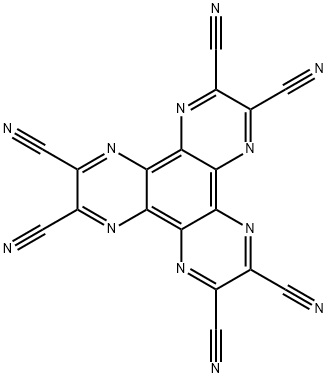Hexaazatriphenylenehexacabonitrile
Synonym(s):1,4,5,8,9,11-Hexaazatriphenylenehexacarbonitrile;Dipyrazino[2,3-f :2′,3′-h ]quinoxaline-2,3,6,7,10,11-hexacarbonitrile;HAT-CN6
- CAS NO.:105598-27-4
- Empirical Formula: C18N12
- Molecular Weight: 384.27
- MDL number: MFCD19689401
- EINECS: 1312995-182-4
- SAFETY DATA SHEET (SDS)
- Update Date: 2024-01-02 16:51:54

What is Hexaazatriphenylenehexacabonitrile?
Description
1,4,5,8,9,11-Hexaazatriphenylenehexacarbonitrile, also known as HAT-CN, is one of the members of the 1,4,5,8,9,12-hexaazatriphenylene (HAT) family, which have?an electron-deficient, rigid, planar, aromatic discotic system with an excellent π–π stacking ability. For this reason, HAT-CN finds applications in organic?light-emitting diodes (OLEDs) serving either as the hole-injection layer (HIL) or charge-generation layer (CGL) material.
The Uses of Hexaazatriphenylenehexacabonitrile
Hole transport layer materials for low voltage top-emitting organic green light emitting devices; a templating material that forces the copper phthalocyanine (CuPc) donor molecule to assume a vertical-standing morphology.
Properties of Hexaazatriphenylenehexacabonitrile
| Melting point: | >500°C |
| Boiling point: | 988.7±65.0 °C(Predicted) |
| Density | 1.86 |
| storage temp. | Inert atmosphere,Room Temperature |
| form | powder or crystals |
| pka | -22.82±0.50(Predicted) |
| color | Dark yellow |
| Absorption | λmax?282, 321 nm (in?CH2Cl2) |
Safety information for Hexaazatriphenylenehexacabonitrile
| Signal word | Warning |
| Pictogram(s) |
 Exclamation Mark Irritant GHS07 |
| GHS Hazard Statements |
H315:Skin corrosion/irritation H319:Serious eye damage/eye irritation H335:Specific target organ toxicity, single exposure;Respiratory tract irritation |
| Precautionary Statement Codes |
P261:Avoid breathing dust/fume/gas/mist/vapours/spray. P264:Wash hands thoroughly after handling. P264:Wash skin thouroughly after handling. P270:Do not eat, drink or smoke when using this product. P271:Use only outdoors or in a well-ventilated area. P280:Wear protective gloves/protective clothing/eye protection/face protection. P302+P352:IF ON SKIN: wash with plenty of soap and water. P305+P351+P338:IF IN EYES: Rinse cautiously with water for several minutes. Remove contact lenses, if present and easy to do. Continuerinsing. P332+P313:IF SKIN irritation occurs: Get medical advice/attention. P337+P313:IF eye irritation persists: Get medical advice/attention. P405:Store locked up. P403+P233:Store in a well-ventilated place. Keep container tightly closed. |
Computed Descriptors for Hexaazatriphenylenehexacabonitrile
Hexaazatriphenylenehexacabonitrile manufacturer
New Products
(S)-3-Aminobutanenitrile hydrochloride 4-Methylphenylacetic acid N-Boc-D-alaninol N-BOC-D/L-ALANINOL 3-Morpholino-1-(4-nitrophenyl)-5,6-dihydropyridin- 2(1H)-one Furan-2,5-Dicarboxylic Acid Tropic acid S-2-CHLORO PROPIONIC ACID ETHYL ISOCYANOACETATE 2-Bromo-1,3-Bis(Dimethylamino)Trimethinium Hexafluorophosphate 4-IODO BENZOIC ACID 3-NITRO-2-METHYL ANILINE 1-(2,4-DICHLOROPHENYL) ETHANAMINE 4-Bromopyrazole 5,6-Dimethoxyindanone Tert-butyl bis(2-chloroethyl)carbamate (2-Hydroxyphenyl)acetonitrile 2-(Cyanocyclohexyl)acetic acid 4-methoxy-3,5-dinitropyridine 1-(4-(aminomethyl)benzyl)urea hydrochloride 2-aminopropyl benzoate hydrochloride diethyl 2-(2-((tertbutoxycarbonyl)amino) ethyl)malonate tert-butyl 4- (ureidomethyl)benzylcarbamate Ethyl-2-chloro((4-methoxyphenyl)hydrazono)acetateRelated products of tetrahydrofuran
You may like
-
 Hexaazatriphenylenehexacabonitrile 98%View Details
Hexaazatriphenylenehexacabonitrile 98%View Details -
![Dipyrazino[2,3-f:2′,3′-h]quinoxaline-2,3,6,7,10,11-hexacarbonitrile CAS 105598-27-4](https://img.chemicalbook.in//Content/image/CP5.jpg) Dipyrazino[2,3-f:2′,3′-h]quinoxaline-2,3,6,7,10,11-hexacarbonitrile CAS 105598-27-4View Details
Dipyrazino[2,3-f:2′,3′-h]quinoxaline-2,3,6,7,10,11-hexacarbonitrile CAS 105598-27-4View Details
105598-27-4 -
 HAT-CN CAS 105598-27-4View Details
HAT-CN CAS 105598-27-4View Details
105598-27-4 -
 1975-50-4 98%View Details
1975-50-4 98%View Details
1975-50-4 -
 2-HYDROXY BENZYL ALCOHOL 98%View Details
2-HYDROXY BENZYL ALCOHOL 98%View Details
90-01-7 -
 2-Chloro-1,3-Bis(Dimethylamino)Trimethinium Hexafluorophosphate 221615-75-4 98%View Details
2-Chloro-1,3-Bis(Dimethylamino)Trimethinium Hexafluorophosphate 221615-75-4 98%View Details
221615-75-4 -
 14714-50-2 (2-Hydroxyphenyl)acetonitrile 98+View Details
14714-50-2 (2-Hydroxyphenyl)acetonitrile 98+View Details
14714-50-2 -
 118753-70-1 98+View Details
118753-70-1 98+View Details
118753-70-1
Statement: All products displayed on this website are only used for non medical purposes such as industrial applications or scientific research, and cannot be used for clinical diagnosis or treatment of humans or animals. They are not medicinal or edible.
